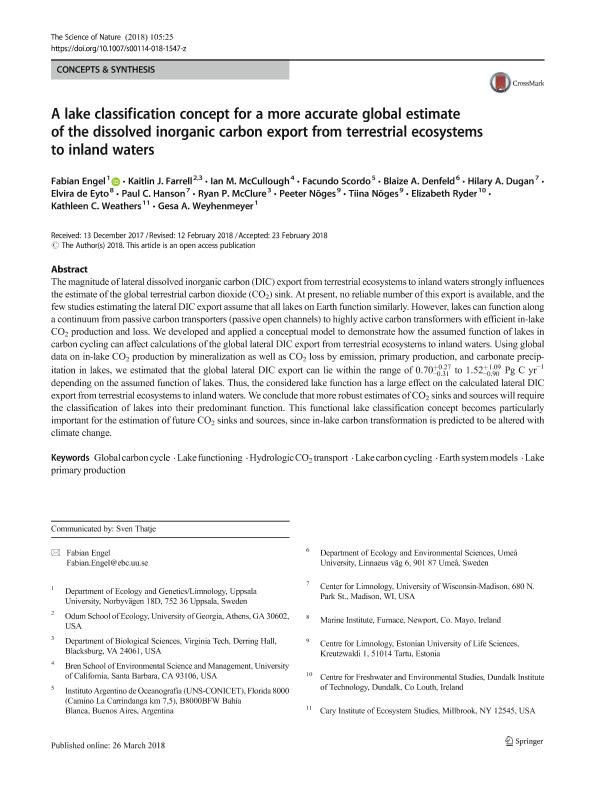Mostrar el registro sencillo del ítem
dc.contributor.author
Engel, Fabian
dc.contributor.author
Farrell, Kaitlin J.
dc.contributor.author
McCullough, Ian M.
dc.contributor.author
Scordo, Facundo

dc.contributor.author
Denfeld, Blaize A.
dc.contributor.author
Dugan, Hilary A.
dc.contributor.author
de Eyto, Elvira
dc.contributor.author
Hanson, Paul C.
dc.contributor.author
McClure, Ryan P.
dc.contributor.author
Nõges, Peter
dc.contributor.author
Nõges, Tiina
dc.contributor.author
Ryder, Elizabeth
dc.contributor.author
Weathers, Kathleen C.
dc.contributor.author
Weyhenmeyer, Gesa A.
dc.date.available
2019-10-18T16:35:51Z
dc.date.issued
2018-03
dc.identifier.citation
Engel, Fabian; Farrell, Kaitlin J.; McCullough, Ian M.; Scordo, Facundo; Denfeld, Blaize A.; et al.; A lake classification concept for a more accurate global estimate of the dissolved inorganic carbon export from terrestrial ecosystems to inland waters; Springer; Die Naturwissenschaften; 105; 3-4; 3-2018
dc.identifier.issn
1432-1904
dc.identifier.uri
http://hdl.handle.net/11336/86377
dc.description.abstract
The magnitude of lateral dissolved inorganic carbon (DIC) export from terrestrial ecosystems to inland waters strongly influences the estimate of the global terrestrial carbon dioxide (CO2) sink. At present, no reliable number of this export is available, and the few studies estimating the lateral DIC export assume that all lakes on Earth function similarly. However, lakes can function along a continuum from passive carbon transporters (passive open channels) to highly active carbon transformers with efficient in-lake CO2 production and loss. We developed and applied a conceptual model to demonstrate how the assumed function of lakes in carbon cycling can affect calculations of the global lateral DIC export from terrestrial ecosystems to inland waters. Using global data on in-lake CO2 production by mineralization as well as CO2 loss by emission, primary production, and carbonate precipitation in lakes, we estimated that the global lateral DIC export can lie within the range of [Formula: see text] to [Formula: see text] Pg C yr-1 depending on the assumed function of lakes. Thus, the considered lake function has a large effect on the calculated lateral DIC export from terrestrial ecosystems to inland waters. We conclude that more robust estimates of CO2 sinks and sources will require the classification of lakes into their predominant function. This functional lake classification concept becomes particularly important for the estimation of future CO2 sinks and sources, since in-lake carbon transformation is predicted to be altered with climate change.
dc.format
application/pdf
dc.language.iso
eng
dc.publisher
Springer

dc.rights
info:eu-repo/semantics/openAccess
dc.rights.uri
https://creativecommons.org/licenses/by-nc-sa/2.5/ar/
dc.subject
EARTH SYSTEM MODELS
dc.subject
GLOBAL CARBON CYCLE
dc.subject
HYDROLOGIC CO2 TRANSPORT
dc.subject
LAKE CARBON CYCLING
dc.subject
LAKE FUNCTIONING
dc.subject
LAKE PRIMARY PRODUCTION
dc.subject.classification
Oceanografía, Hidrología, Recursos Hídricos

dc.subject.classification
Ciencias de la Tierra y relacionadas con el Medio Ambiente

dc.subject.classification
CIENCIAS NATURALES Y EXACTAS

dc.subject.classification
Ciencias Medioambientales

dc.subject.classification
Ciencias de la Tierra y relacionadas con el Medio Ambiente

dc.subject.classification
CIENCIAS NATURALES Y EXACTAS

dc.title
A lake classification concept for a more accurate global estimate of the dissolved inorganic carbon export from terrestrial ecosystems to inland waters
dc.type
info:eu-repo/semantics/article
dc.type
info:ar-repo/semantics/artículo
dc.type
info:eu-repo/semantics/publishedVersion
dc.date.updated
2019-09-10T19:51:42Z
dc.journal.volume
105
dc.journal.number
3-4
dc.journal.pais
Alemania

dc.journal.ciudad
Berlin
dc.description.fil
Fil: Engel, Fabian. Uppsala University; Suecia
dc.description.fil
Fil: Farrell, Kaitlin J.. University of Georgia; Estados Unidos. Virginia Tech University; Estados Unidos
dc.description.fil
Fil: McCullough, Ian M.. University of California; Estados Unidos
dc.description.fil
Fil: Scordo, Facundo. Consejo Nacional de Investigaciones Científicas y Técnicas. Centro Científico Tecnológico Conicet - Bahía Blanca. Instituto Argentino de Oceanografía. Universidad Nacional del Sur. Instituto Argentino de Oceanografía; Argentina
dc.description.fil
Fil: Denfeld, Blaize A.. Universidad de Umea; Suecia
dc.description.fil
Fil: Dugan, Hilary A.. University of Wisconsin; Estados Unidos
dc.description.fil
Fil: de Eyto, Elvira. Marine Institute; Irlanda
dc.description.fil
Fil: Hanson, Paul C.. University of Wisconsin; Estados Unidos
dc.description.fil
Fil: McClure, Ryan P.. Virginia Tech University; Estados Unidos
dc.description.fil
Fil: Nõges, Peter. Estonian University of Life Sciences. Centre for Limnology; Estonia
dc.description.fil
Fil: Nõges, Tiina. Estonian University of Life Sciences. Centre for Limnology; Estonia
dc.description.fil
Fil: Ryder, Elizabeth. Dundalk Institute of Technology; Irlanda
dc.description.fil
Fil: Weathers, Kathleen C.. Cary Institute Of Ecosystem Studies; Estados Unidos
dc.description.fil
Fil: Weyhenmeyer, Gesa A.. Uppsala University; Suecia
dc.journal.title
Die Naturwissenschaften

dc.relation.alternativeid
info:eu-repo/semantics/altIdentifier/url/http://link.springer.com/10.1007/s00114-018-1547-z
dc.relation.alternativeid
info:eu-repo/semantics/altIdentifier/doi/http://dx.doi.org/10.1007/s00114-018-1547-z
Archivos asociados
